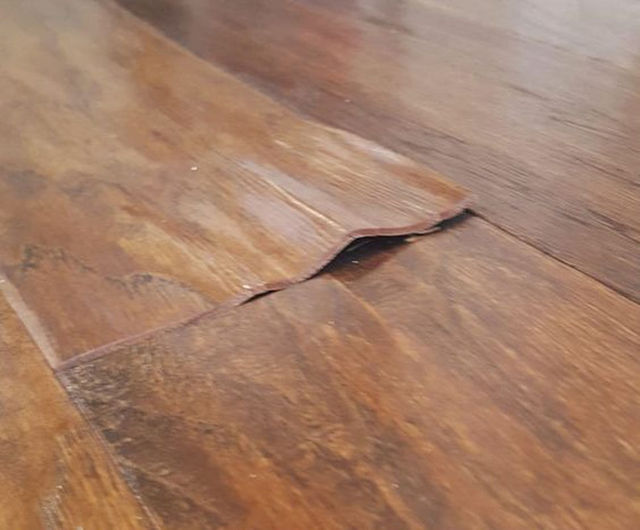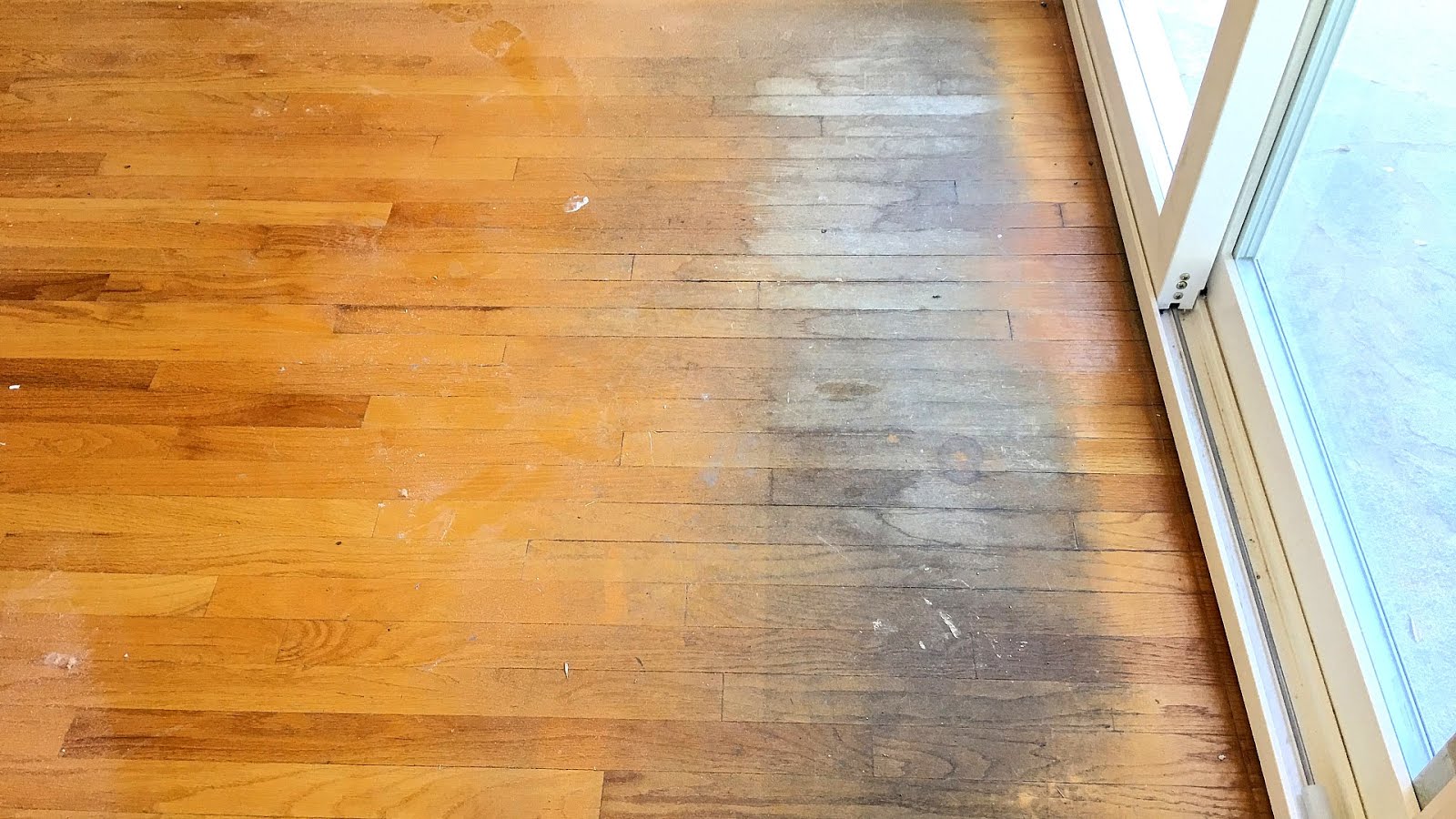Imagine this: you walk into your home after a long day, ready to relax, only to be met with a horrifying sight – your once beautiful hardwood floors have buckled, warped, and twisted, victims of a water leak. It’s a nightmare scenario that can leave you feeling helpless and overwhelmed. But don’t despair! While water damage can be a serious issue, it’s not always a death sentence for your hardwood floors. With the right knowledge and approach, you can often restore them to their former glory.

Image: www.dashangu.com
This comprehensive guide will equip you with the essential information and practical steps to tackle buckled hardwood floors caused by water damage. We’ll delve into the root causes of this problem, explore effective repair techniques, and provide valuable tips to prevent future water damage. By following this guide, you can regain control over your home, minimize the impact of water damage, and hopefully save your beloved hardwood floors.
Understanding the Problem: Why Do Hardwood Floors Buckle?
Water and wood are not a harmonious pair. Hardwood flooring, despite its elegance and durability, is susceptible to the ill effects of moisture. When water seeps beneath your floorboards, it can cause several problems leading to buckling:
- Expansion and Contraction: Water causes the wood to expand. As it dries, the wood shrinks, but not always evenly. This inconsistent shrinking can lead to gaps, warping, and buckling.
- Structural Damage: Water weakens the subfloor and joists beneath the hardwood. This weakened structure can no longer support the weight of the flooring, causing it to sag and buckle.
- Mold and Mildew Growth: Water creates a breeding ground for mold and mildew, which can not only damage the wood but also pose health risks.
Assessing the Damage: Determining the Extent of the Problem
Before jumping into repairs, it’s crucial to assess the extent of the water damage. This helps you determine the best course of action and prevents unnecessary work. Here’s a step-by-step guide:
- Identify the Source: Track down the source of the leak. This might require detective work, but finding the culprit is essential to prevent further damage.
- Visual Inspection: Examine the buckled floorboards for signs of water damage: warping, discoloration, soft spots, or mold growth.
- Moisture Testing: Use a moisture meter to measure the moisture content of the wood. This helps to gauge the severity of the damage.
- Consider the Subfloor: If the subfloor feels spongy or soft underfoot, water damage may have extended beyond the hardwood.
Repairing the Damage: Steps to Salvage Your Hardwood Floors
Once you’ve assessed the damage, you can begin the repair process. Depending on the extent of the damage, the repair will range from simple fixes to more complex procedures. Here’s a breakdown:

Image: thedamagechoices.blogspot.com
1. Drying the Floor: The Foundation of Repair
The first step is to thoroughly dry the floor. This crucial step prevents further damage and sets the stage for successful repairs.
- Ventilation: Open windows and doors to allow air circulation and hasten the drying process.
- Dehumidifiers: Use a powerful dehumidifier to remove excess moisture from the air.
- Fans: Place fans to circulate air and accelerate drying.
- Professional Drying: For extensive water damage, consider hiring a professional water damage restoration company to handle the drying process.
2. Addressing Subfloor Issues: Stabilizing the Base
If the subfloor is damaged, addressing the structural issues is crucial:
- Replace Damaged Subfloor: Remove any rotted or damaged subfloor planks and replace them with new, moisture-resistant plywood.
- Strengthen Joists: If the joists are weakened, they may need to be reinforced or replaced.
- Install a Moisture Barrier: To prevent future water damage, install a moisture barrier over the subfloor.
3. Dealing with Buckled Floorboards: The Heart of Repair
Once the subfloor is dry and stable, you can focus on the buckled floorboards:
- Simple Lifting: For slight buckling, carefully pry up the boards with a pry bar and re-nail them to the subfloor.
- Planing and Sanding: For boards that have warped, you can carefully plane them down to make them flat again. Sanding may be necessary to smooth out the surface.
- Replacing Damaged Boards: For severely damaged boards, you’ll need to replace them. This involves removing the old board, installing a new one, and securing it with nails or screws.
4. Finishing Touches: Reclaiming the Beauty
Once the structural work is complete, you can restore the floor’s appearance:
- Staining and Finishing: If the existing finish is damaged, you may need to re-stain and refinish the entire floor for a uniform look.
- Patchwork: For isolated areas of damage, you can use a filler to patch up gaps and imperfections.
- Professional Refinishing: For extensive damage or a desire for a flawless finish, seek professional help for sanding and refinishing.
Expert Insights: Preventing Future Water Damage
To minimize the risk of future water damage, incorporate these expert tips into your home maintenance routine:
- Regular Inspections: Inspect your home’s plumbing for leaks regularly. Pay attention to signs of dripping faucets, leaky pipes, or damaged hoses.
- Repair Promptly: Don’t ignore even minor leaks. Address them immediately to prevent more serious problems.
- Monitor Appliances: Check your washing machine hoses, dishwasher connections, and refrigerator lines for leaks.
- Protect from Outside Water: Inspect your roof, gutters, and downspouts for any damage that could lead to water infiltration.
- Create a “Safe Zone”: Elevate valuable items in your basement or areas prone to flooding to keep them safe.
How To Fix Buckled Hardwood Floors From Water Damage
Conclusion: Empowering You to Restore Your Home
Water damage to hardwood floors can be a daunting challenge. But by understanding the causes, assessing the damage accurately, and implementing the right repair techniques, you can reclaim your beautiful floors. Remember, prevention is key. Regular maintenance and proactive steps can significantly minimize the risk of future water damage, saving you from the heartache of seeing your cherished hardwood floors buckle. Now, go forth, armed with the knowledge and courage to face any water damage challenges your home may encounter.






